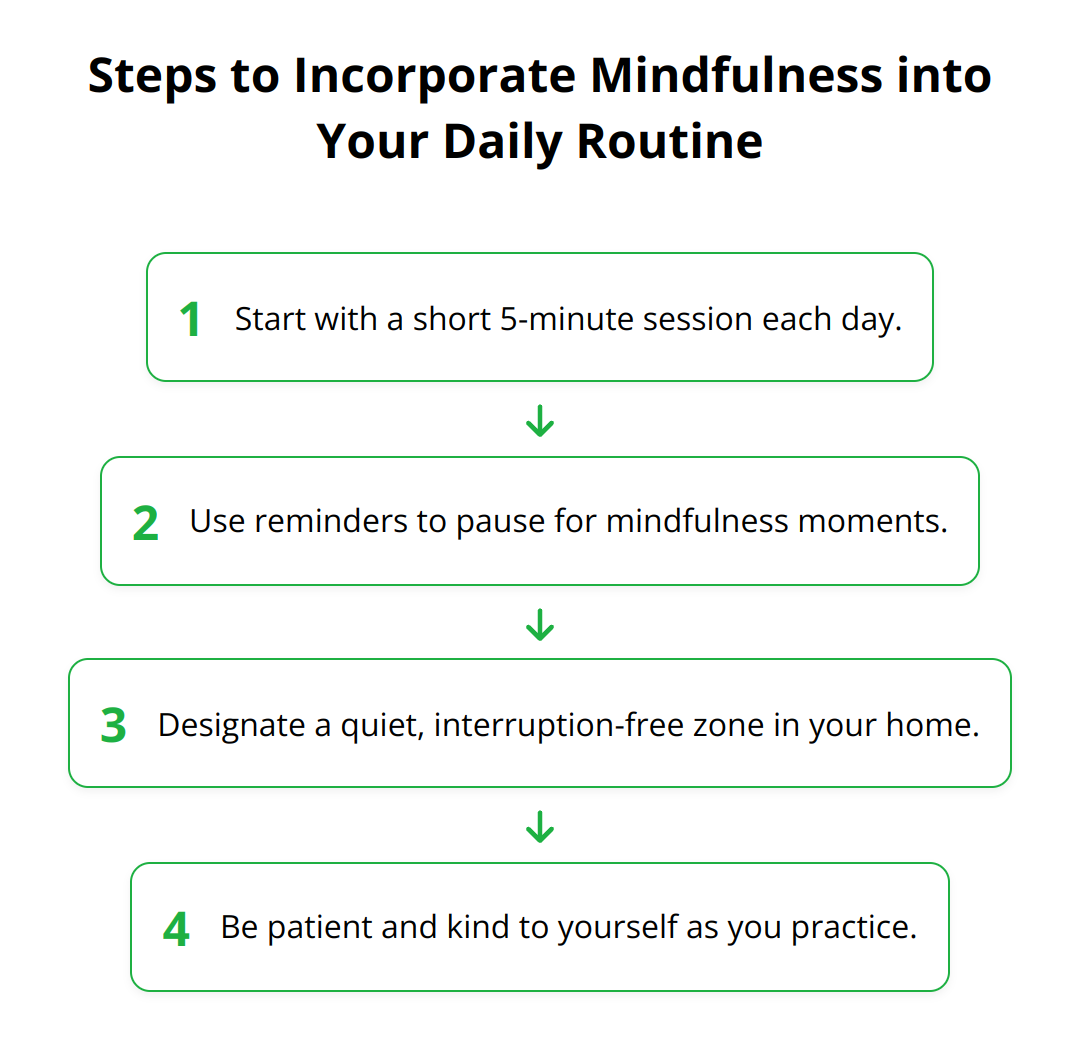Stress is a common challenge that impacts our health and well-being significantly. At Pure Hemp Essentials, we understand the importance of managing stress effectively. This guide offers practical exercises to help you relax and find peace amidst your busy life. Dive into deep breathing, progressive muscle relaxation, and mindfulness practices to transform your approach to stress management.
Deep Breathing Techniques
Deep breathing is not just about taking big breaths. It’s a deliberate method that positively impacts your stress levels, mental health, and overall well-being. By integrating deep breathing into your daily routine, you’re tapping into a natural method to lower stress and enhance relaxation.
The Essentials of Deep Breathing
Deep breathing works by engaging the parasympathetic nervous system, which counters the stress-induced responses of the body. It helps in lowering the heart rate, reducing blood pressure, and slowing down the pace of breath—all of which contribute to a state of calmness.
A Step-By-Step Guide
- Find a Comfortable Spot: Sit or lie down in a quiet and comfortable space. Maintain a posture that allows your chest and belly to fully expand.
- Focus on Your Breath: Close your eyes to block out distractions. Place one hand on your chest and the other on your belly.
- Inhale Deeply: Slowly inhale through your nose, ensuring that your belly rises higher than your chest.
- Hold and Exhale: Hold your breath for a moment and then exhale slowly through your mouth or nose, whichever feels more comfortable.
- Repeat: Continue this process for 5-10 minutes.

Practicing this technique for a few minutes daily can significantly lower stress levels and improve your mood. It’s a powerful tool that’s always at your disposal, requiring no special equipment or environment.
How It Lowers Stress
Deep breathing acts directly on the nervous system to induce a sense of calm. It helps in minimizing the intensity of the body’s stress response, decreasing anxiety levels and fostering a more balanced emotional state. Additionally, this practice increases oxygen supply to your brain. Enhanced oxygen levels stimulate the parasympathetic nervous system, promoting a state of serenity.
Consider incorporating deep breathing into your daily wellness routine. It is especially useful during periods of heightened stress or before engaging in tasks that require focus and calm. As you make deep breathing a habit, you’ll notice a sustainable improvement in your ability to manage stress and maintain a clearer mind.
For more insights and practical tips on managing anxiety naturally, check out our guide on managing anxiety naturally. It’s packed with actionable advice and natural remedies to help you lead a more balanced life.

Remember, the key to leveraging the full benefits of deep breathing is consistency. Make it a part of your daily self-care practice, and you’ll discover its profound impact on your peace of mind and overall well-being.
Progressive Muscle Relaxation Explained
Progressive Muscle Relaxation (PMR) is an effective stress reduction technique that involves tensing and then relaxing each muscle group in the body. This method reduces stress by promoting relaxation throughout the body and has been recommended by health professionals for decades.
The method hinges on the contrast between muscle tension and relaxation, highlighting how different these states feel. This awareness can naturally lead to a deeper state of relaxation. It’s particularly beneficial for individuals who experience stress physically, such as muscle tension or headaches.

Understanding the Method and Its Application
PMR works by systematically going through each muscle group, first tensing the muscles as hard as possible (without straining) for about five seconds, and then suddenly releasing. The sudden release of muscle tension leads to a noticeable state of relaxation that can noticeably reduce stress levels.
Steps for Maximum Effectiveness
- Choose a Quiet Environment: A calm setting enhances focus and effectiveness.
- Comfortable Position: Lie down or sit in a chair, ensuring total body support.
- Start from the Top: Begin with the muscles in your forehead, then systematically move down to your toes.
- Tense, Hold, Release: Tense each muscle group firmly but without strain, hold for about five seconds, and then release.
- Breathe Well: Pair the exercise with deep breathing for enhanced relaxation.
- Practice Regularly: Consistency is key for lasting stress relief.
Practical Tips for Better Outcomes
- Engagement: Focus on the tension-release process to get the most out of each session.
- Consistency Over Intensity: It’s more beneficial to practice regularly rather than to perform the exercises intensely once in a while.
- Mindfulness: Use PMR as a time to tune into your body, enhancing mindfulness and present-moment awareness.
- Pair with Deep Breathing: Integrating deep breathing with PMR can amplify stress-reduction benefits. Learn more about deep breathing with our stress management strategies.
- Start Slow: If you’re new to PMR, start with just a few muscle groups and gradually include more over time.
Why It’s Highly Recommended
PMR is not just about physical relaxation; it’s a gateway to mental calmness. By reducing physical tension, the mind also unwinds, reflecting the close link between body and mind when it comes to stress management.
Furthermore, practicing PMR can lead to long-term benefits in managing anxiety, improving sleep quality, and even lowering blood pressure. It’s a tool that requires no special equipment, making it accessible to everyone, anytime, anywhere. For those particularly interested in natural remedies for managing anxiety, our guide offers more comprehensive insights and practical advice.
As you incorporate PMR into your routine, remember that persistence is key. The more you practice, the quicker you’ll notice the benefits. This simple, yet effective technique holds the power to significantly reduce stress and improve overall well-being, making it a valuable addition to your daily routine.
Harnessing Mindfulness for Stress Reduction
Mindfulness is the art of staying fully present in the moment without judgment. In an era where multi-tasking and digital distractions are the norm, dedicating time to mindfulness and meditation is essential for mental health and stress reduction. These practices offer a refuge from the chaos of daily life, providing a space for inner peace and clarity.
Mindfulness: A Powerful Tool for Well-being
Mindfulness invites you to experience life as it unfolds, without filtering or reacting. It’s a powerful tool that enhances awareness and encourages a deeper connection with your own thoughts and feelings. Embracing mindfulness leads to numerous health benefits, including reduced stress, improved emotional regulation, and an enhanced sense of well-being.
One compelling fact is that regularly engaging in mindfulness practices can actually change the structure of your brain. Research has shown that mindfulness meditation can increase gray matter in areas associated with memory, self-awareness, and empathy, while decreasing gray matter in the amygdala, the region related to stress and anxiety.
Meditation Techniques That Fight Stress
There are several meditation techniques, each with distinct approaches but a common goal: peace of mind.
- Focused Attention Meditation involves concentrating on a single object, thought, sound, or visualization. It emphasizes returning your focus whenever the mind wanders.
- Body Scan Meditation is a practice where you mentally scan your body for areas of tension. The goal is to notice tension and allow it to release.
- Loving-Kindness Meditation strengthens feelings of compassion, kindness, and acceptance toward oneself and others.
- Mindfulness-Based Stress Reduction (MBSR) is an eight-week program that offers intensive mindfulness training to assist people with stress, anxiety, depression, and pain.
Adapting any of these practices into your routine can markedly lower stress levels and enhance your quality of life.
Building a Consistent Mindfulness Practice
Consistency is key to reaping the full benefits of mindfulness and meditation. Here are some tips to help make mindfulness a daily habit:
- Start Small: Begin with as little as 5 minutes a day and gradually increase the duration.
- Set a Reminder: Use alarms or calendar notifications as reminders to take moments for mindfulness throughout your day.
- Find a Quiet Space: Designate a peaceful area in your home where you can practice without interruptions.
- Be Patient With Yourself: Mindfulness is a skill that develops over time. Do not get discouraged by distractions or wandering thoughts.

For those looking to dive deeper into meditation, exploring guided meditations can be extremely helpful. Apps like Headspace or websites offering guided meditation resources provide a variety of guided sessions that cater to different goals, from stress reduction to improving sleep.
Incorporating mindfulness and meditation into your life is an empowering step towards improved mental health and resilience against stress. It’s not just about reducing stress in the moment; it’s about building a foundation of calm and clarity that supports you through every aspect of life.
Final Thoughts
In our comprehensive guide, we’ve explored several effective stress reduction exercises that have stood the test of time. From the calming rhythms of deep breathing to the physical and mental release provided by Progressive Muscle Relaxation (PMR), and the mindful awareness cultivated through various meditation techniques, we’ve offered you tools that can significantly improve your well-being by managing stress effectively.
![Key Takeaways - Stress Reduction Exercises [Guide]](https://purehempessentials.com/wp-content/uploads/2024/03/Stress_Reduction_Exercises__Guide__5_2024_03_24_07_06_17_128186_00_00.png)
Incorporating these exercises into your daily routine doesn’t require monumental effort but rather a commitment to small, consistent actions. By dedicating just a few minutes each day to practices like deep breathing, PMR, or mindfulness, you can create a powerful ripple effect on your overall health and stress levels. The beauty of these practices is their adaptability—they can be tailored to fit your lifestyle and preferences, ensuring that stress management becomes an integral and enjoyable part of your daily life.
We at Pure Hemp Essentials encourage you to view stress management as a continuous journey rather than a destination. The path to reducing stress and enhancing well-being is ongoing, one that evolves with our changing lives and circumstances. As you incorporate these exercises into your routine, remain open to exploring additional wellness strategies that support your journey.
For those looking to further support their wellness journey, we invite you to explore our Hempworx CBD collection. Our range of CBD oils, skincare, and wellness products offers additional natural solutions to enhance your stress management practices. Discover our selection and how it can complement your wellness routine at Pure Hemp Essentials.
Remember, the journey to managing stress effectively is personal and unique to each individual. By taking proactive steps and incorporating these practices, you’re investing in your long-term health and happiness. Stay committed, be patient with yourself, and celebrate the progress along the way. Together, let’s embrace a life of reduced stress and increased peace and well-being.
